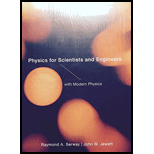
Concept explainers
(a)
The power transmitted by the wave as a function of
(a)
Answer to Problem 58AP
The power transmitted by the wave as a function of
Explanation of Solution
Write the expression for the power transmitted.
Here,
Write the general expression for wave function of the wave.
Here,
The derivative of the position of the wave gives velocity of the wave.
Differentiate equation (II) with respect to
The maximum velocity will be
Rewrite equation (I) by substituting
Write the expression for speed of the wave.
Here,
Conclusion:
Substitute,
Substitute,
Therefore, power transmitted by the wave as a function of
(b)
The proportionality between power and
(b)
Answer to Problem 58AP
The power transmitted is directly proportional to the square of the maximum speed of the particle.
Explanation of Solution
Write the expression for the power transmitted.
Here,
Write the general expression for wave function of the wave.
Here,
The derivative of the position of the wave gives velocity of the wave.
Differentiate equation (II) with respect to
The maximum velocity will be
Rewrite equation (I) by substituting
According to equation (VII) the power transmitted is directly proportional to square of the maximum speed.
Conclusion:
Therefore, the power transmitted is directly proportional to the Square of the maximum speed of the particle.
(c)
The energy contained in a section of string 3.00 m long as a function of
(c)
Answer to Problem 58AP
The energy contained in a section of string 3.00 m long as a function of
Explanation of Solution
Write the expression for energy in terms of power.
Here,
Write the expression for time in terms of speed and distance.
Conclusion:
Substitute,
Substitute,
Therefore, the energy contained in a section of string 3.00 m long as a function of
(d)
The energy contained in a section of string 3.00 m long as a function of mass.
(d)
Answer to Problem 58AP
The energy contained in a section of string 3.00 m long as a function of mass is
Explanation of Solution
Write the expression for kinetic energy in the string
Here,
Conclusion:
Therefore, the energy contained in a section of string 3.00 m long as a function of mass is
(e)
The energy that the wave carries past a point in
(e)
Answer to Problem 58AP
The energy that the wave carries past a point in
Explanation of Solution
Use equation (VIII) to obtain the energy carried by the wave.
Conclusion:
Substitute,
Therefore, the energy that the wave carries past a point in
Want to see more full solutions like this?
Chapter 16 Solutions
Physics For Scientists And Engineers With Modern Physics, 9th Edition, The Ohio State University
- star by spaceship Sixus is about 9.00 ly from Earth. To preach the star in 15.04 (ship time), how fast must you travel? C.arrow_forwardIf light-bulb A is unscrewed, how will the brightness of bulbs B and C change, if at all? How does the current drawn by from the battery change?arrow_forwardCan someone help mearrow_forward
- Can someone help me with this thank youarrow_forward(a) For a spherical capacitor with inner radius a and outer radius b, we have the following for the capacitance. ab C = k₂(b- a) 0.0695 m 0.145 m (8.99 × 10º N · m²/c²)( [0.145 m- 0.0695 m × 10-11 F = PF IIarrow_forwardA pendulum bob A (0.5 kg) is given an initialspeed of vA = 4 m/s when the chord ishorizontal. It then hits a stationary block B (1kg) which then slides to a maximum distanced before it stops. Determine the value of d.The coefficient of static friction between theblock and the plane is μk = 0.2. The coefficientof restitution between A and B is e = 0.8.Ans: d=1.0034 marrow_forward
- Figure 29-43 Problem 12. ••13 In Fig. 29-44, point P₁ is at distance R = 13.1 cm on the perpendicular bisector of a straight wire of length L = 18.0 cm carrying current i = 58.2 mA. (Note that the wire is not long.) What is the magnitude of the magnetic field at P₁ due to i? P2° R R Larrow_forwardCheckpoint 1 The figure shows the current i in a single-loop circuit with a battery B and a resistance R (and wires of neg- ligible resistance). (a) Should the emf arrow at B be drawn pointing leftward or rightward? At points a, B C R b, and c, rank (b) the magnitude of the current, (c) the electric potential, and (d) the electric potential energy of the charge carriers, greatest first.arrow_forwardPls help ASAParrow_forward
 University Physics Volume 1PhysicsISBN:9781938168277Author:William Moebs, Samuel J. Ling, Jeff SannyPublisher:OpenStax - Rice University
University Physics Volume 1PhysicsISBN:9781938168277Author:William Moebs, Samuel J. Ling, Jeff SannyPublisher:OpenStax - Rice University Physics for Scientists and Engineers: Foundations...PhysicsISBN:9781133939146Author:Katz, Debora M.Publisher:Cengage Learning
Physics for Scientists and Engineers: Foundations...PhysicsISBN:9781133939146Author:Katz, Debora M.Publisher:Cengage Learning Principles of Physics: A Calculus-Based TextPhysicsISBN:9781133104261Author:Raymond A. Serway, John W. JewettPublisher:Cengage Learning
Principles of Physics: A Calculus-Based TextPhysicsISBN:9781133104261Author:Raymond A. Serway, John W. JewettPublisher:Cengage Learning Classical Dynamics of Particles and SystemsPhysicsISBN:9780534408961Author:Stephen T. Thornton, Jerry B. MarionPublisher:Cengage Learning
Classical Dynamics of Particles and SystemsPhysicsISBN:9780534408961Author:Stephen T. Thornton, Jerry B. MarionPublisher:Cengage Learning Physics for Scientists and Engineers, Technology ...PhysicsISBN:9781305116399Author:Raymond A. Serway, John W. JewettPublisher:Cengage Learning
Physics for Scientists and Engineers, Technology ...PhysicsISBN:9781305116399Author:Raymond A. Serway, John W. JewettPublisher:Cengage Learning Physics for Scientists and EngineersPhysicsISBN:9781337553278Author:Raymond A. Serway, John W. JewettPublisher:Cengage Learning
Physics for Scientists and EngineersPhysicsISBN:9781337553278Author:Raymond A. Serway, John W. JewettPublisher:Cengage Learning





